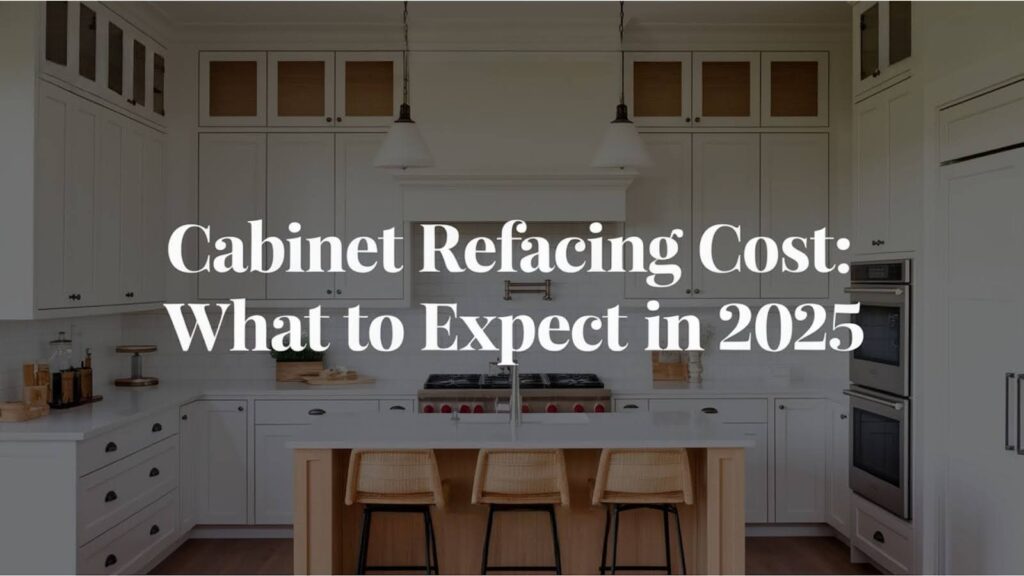Cabinet refacing involves replacing cabinet doors, drawer fronts, and hardware while keeping the existing cabinet boxes intact.
This process gives your kitchen a fresh, updated look without the expense and disruption of a complete remodel.
Instead of tearing out entire cabinets, refacing allows homeowners to achieve a brand-new appearance at a fraction of the cost.
This approach has become increasingly popular as homeowners seek cost-effective ways to modernize their kitchens.
In this post, we’ll examine 2025 pricing trends for cabinet refacing, explore the key factors that influence costs, compare refacing to other renovation options, and provide practical tips to help you budget effectively for your kitchen update project.
What Is Cabinet Refacing?
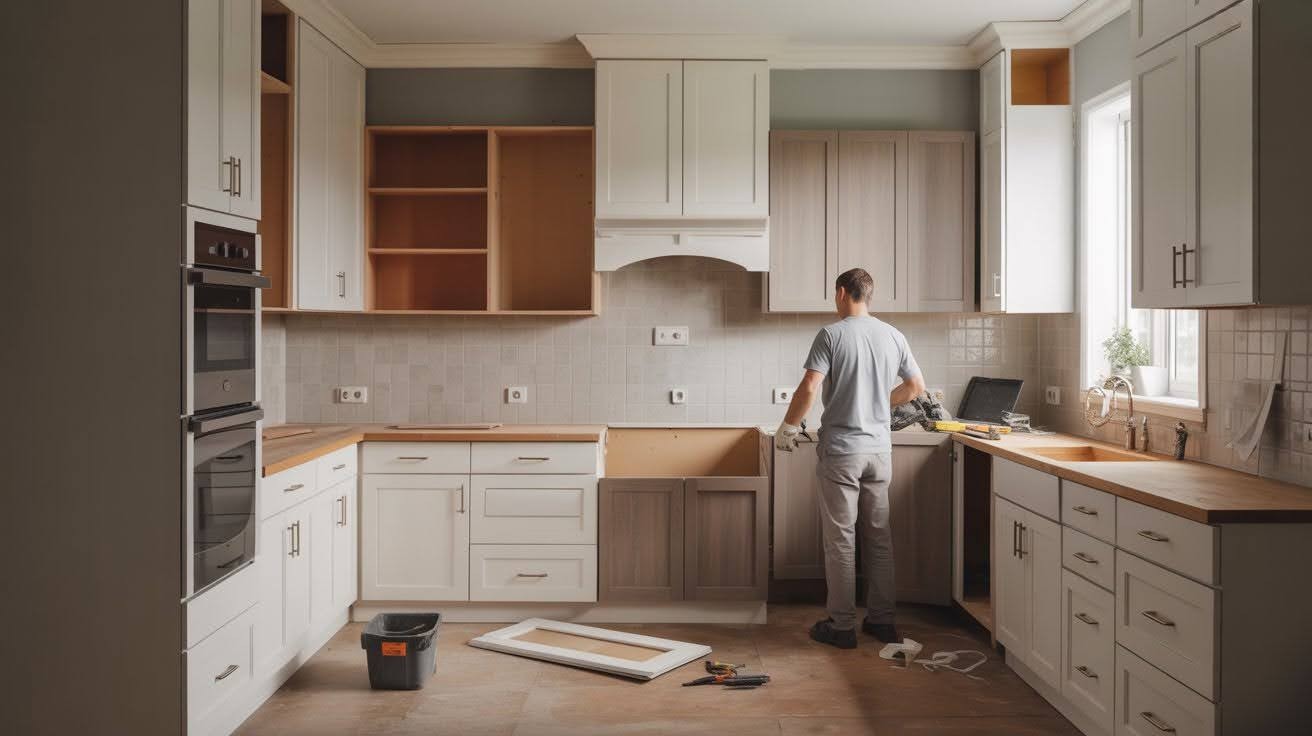
Cabinet refacing updates kitchen cabinets by replacing doors and drawer fronts while keeping existing boxes, offering affordable renovation alternatives.
Definition and Basic Process
Cabinet refacing is a kitchen renovation technique that updates your cabinets by replacing the visible surfaces while preserving the structural framework.
The process involves removing existing cabinet doors, drawer fronts, and hardware, then installing new ones along with matching veneer or laminate on the cabinet frames.
Most contractors, like the professionals from Cabinet Coatings, typically complete this work in less than a week, depending on kitchen size.
The existing cabinet boxes remain in place, making this method significantly less disruptive than full replacement.
Most refacing projects also include new hinges, handles, and interior shelving adjustments to complete the transformation.
How It Differs from Replacing or Painting Cabinets
Refacing occupies a middle ground between painting and full cabinet replacement. Unlike painting, which simply applies a new color to existing surfaces, refacing completely changes the cabinet doors and drawer fronts with new materials.
This provides more design flexibility and durability than paint alone. Compared to full replacement, refacing costs 30-50% less while achieving similar visual results.
Cabinet replacement requires removing all components, potentially affecting plumbing and electrical connections.
Refacing maintains the original cabinet layout and avoids structural modifications, reducing both time and expense.
Common Reasons Homeowners Choose Refacing
Cost savings represent the primary motivation for most homeowners considering refacing. The process typically costs $4,000-$15,000 compared to $20,000-$50,000 for complete cabinet replacement.
Time efficiency also appeals to busy families, as refacing projects cause minimal kitchen disruption. Many homeowners appreciate keeping their existing cabinet layout, especially when the current configuration functions well.
Environmental considerations motivate others, as refacing reduces waste by reusing cabinet boxes.
Quality cabinet boxes from previous decades often surpass modern alternatives in durability, making refacing a practical choice for preserving superior construction while updating appearance.
Average Cabinet Refacing Costs
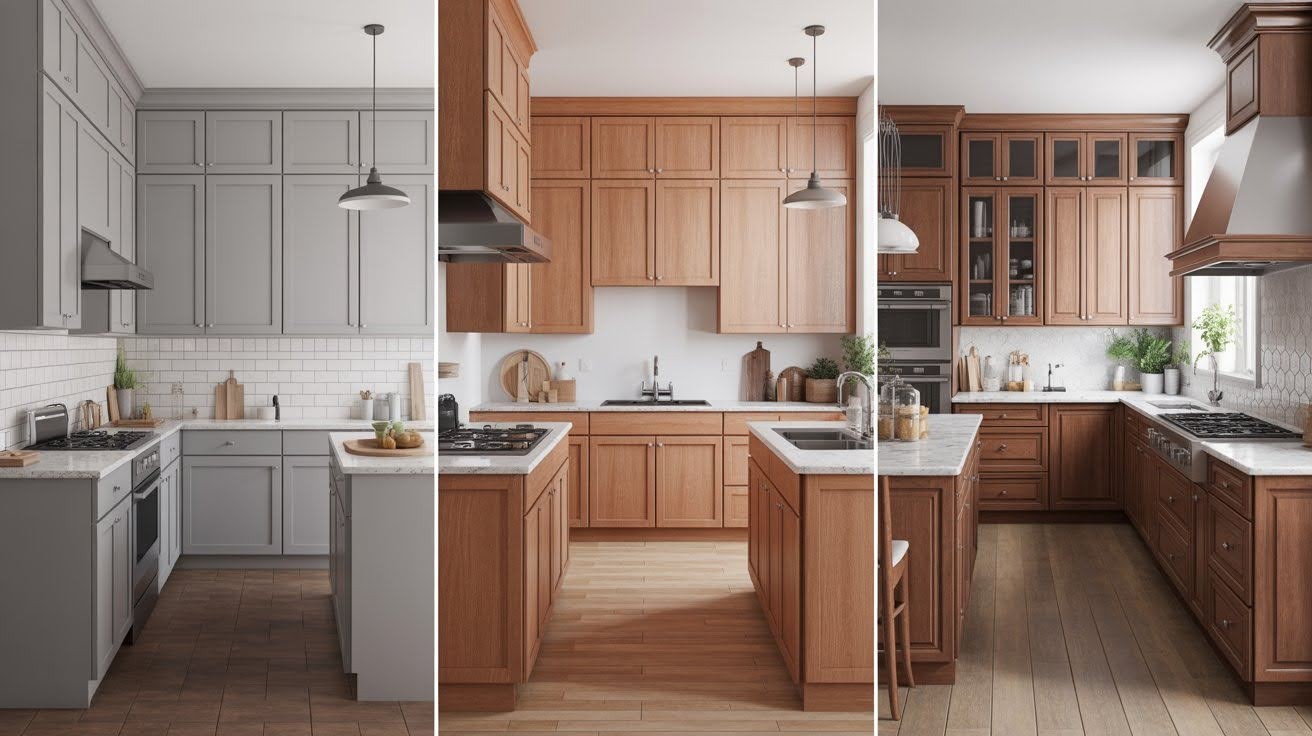
Cabinet refacing costs vary by kitchen size, ranging from $5,000 for small spaces to $15,000+ for large custom kitchens.
Small Kitchens
- Cost range: $5,000 to $10,000
- Typically contains 10-15 cabinet doors and drawer fronts
- Lower costs apply to basic laminate finishes with standard hardware
- Higher costs include wood veneer options or premium details
- Galley kitchens and compact layouts commonly fall into this category
- Significantly less expensive than full replacement, which exceeds $15,000
Average-Sized Kitchens
- Cost range: $8,000 to $12,000 for most standard kitchens
- Features 15-25 cabinet doors and drawer fronts
- Often includes kitchen island or peninsula
- Laminate options stay closer to $8,000
- Solid wood veneers approach $12,000
- Additional features like soft-close hinges or crown molding increase costs
- Excellent value compared to full renovations starting at $25,000
Large or Custom Kitchens
- Cost range: $10,000 to $15,000 or more
- Features 25+ cabinet doors with multiple islands or pantry areas
- Custom elements and specialty finishes increase costs beyond base range
- High-end materials like exotic wood veneers raise pricing
- Complex configurations require additional labor and materials
- Still provides substantial savings compared to complete replacement ($40,000-$80,000+)
Cost Comparison Table
| Upgrade Type | Cost Range | Time Required |
| Painting | $2,000-$8,000 | 3-5 Days |
| Refacing | $7,000-$15,000 | ~5 Days |
| Refacing + New Uppers | $11,000-$16,000 | ~5-7 Days |
| Full Remodel | $30,000-$50,000+ | 4-6 Months |
What’s Included in Cabinet Refacing Projects
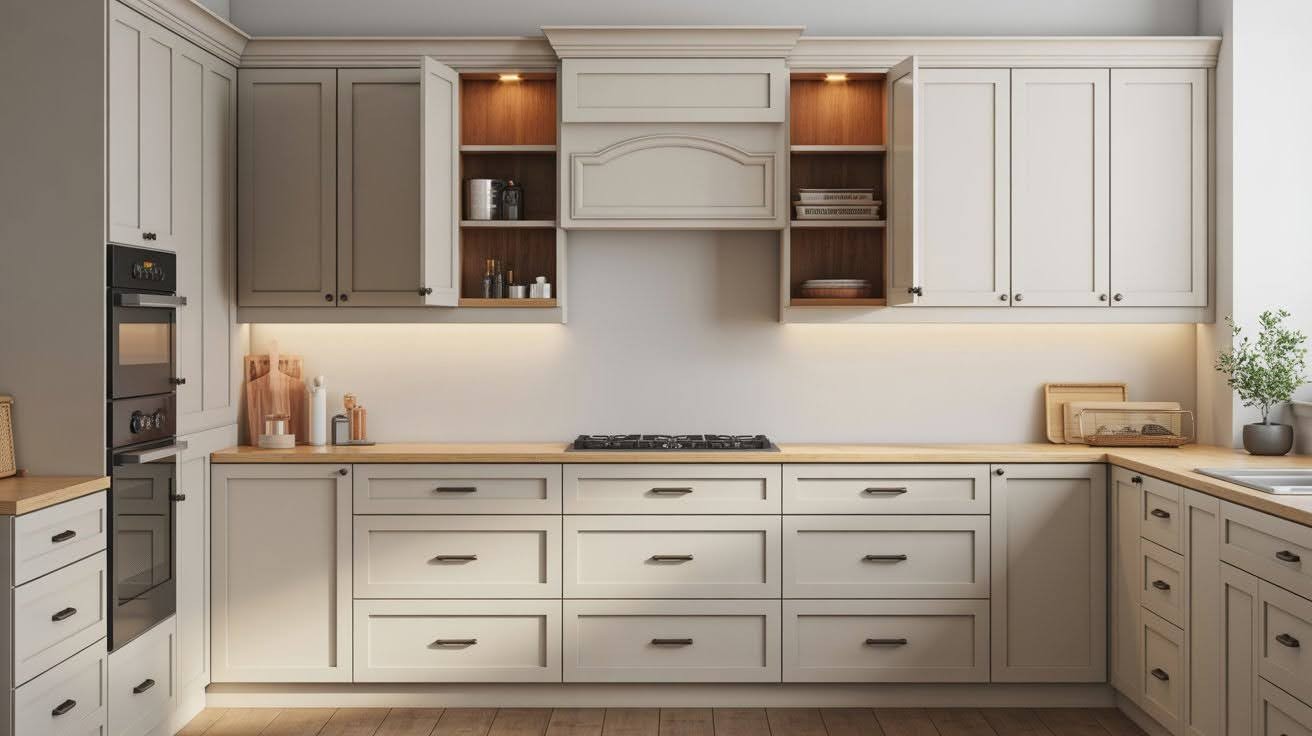
Cabinet refacing projects include new doors, drawer fronts, veneer application, decorative elements, and optional storage upgrades for complete kitchen transformation.
New Doors and Drawer Fronts
Cabinet refacing projects begin with complete replacement of all cabinet doors and drawer fronts using new materials and finishes.
Homeowners can choose from a wide selection of styles including shaker, raised panel, flat panel, and contemporary designs.
Material options range from laminate and thermofoil to solid wood and wood veneer, allowing for various budget levels and aesthetic preferences.
Each component is custom-sized to fit existing cabinet openings perfectly, ensuring proper alignment and spacing during professional installation. The quality construction is designed to withstand years of regular use while maintaining its appearance.
Veneer or Paint for Cabinet Boxes
All visible cabinet frame surfaces receive matching veneer or paint application to coordinate with the new doors and drawer fronts.
Professional surface preparation ensures optimal adhesion and longevity of the finish. When veneer isn’t preferred, high-quality paint options provide excellent coverage of exposed cabinet surfaces including face frames.
The materials resist chipping and wear while creating seamless integration between new and existing cabinet components. This process ensures that all visible surfaces present a cohesive, updated appearance throughout the kitchen.
Decorative End Panels and Crown Molding
Custom end panels cover exposed cabinet sides, while crown molding installation creates a finished, built-in appearance.
All materials and finishes match the new doors to maintain design continuity. Professional trim work around cabinet perimeters includes light rail molding under upper cabinets when requested.
Filler strips close gaps between cabinets and walls, and detailed finishing touches complete the overall look. These elements transform basic cabinet boxes into sophisticated, custom-appearing installations that rival new construction quality.
Optional Storage Upgrades
Many refacing projects include storage improvements such as pull-out shelves and drawer systems for better organization.
Lazy Susans improve corner cabinet accessibility, while soft-close hinges and drawer slides provide quiet operation.
Interior cabinet lighting improves visibility, and adjustable shelf systems offer flexible storage options.
Door-mounted organizers, spice racks, and pantry pull-out systems maximize storage efficiency. These upgrades can be added during the refacing process at a fraction of the cost compared to standalone installations.
Factors That Affect Cabinet Refacing Cost
- Kitchen size and cabinet count directly impact refacing costs, with larger spaces requiring more materials and labor
- Door style complexity affects pricing, as simple flat-panel designs cost less than intricate raised-panel options
- Material selection significantly influences expenses, with solid wood commanding premium prices over laminate or thermofoil alternatives
- Finish type plays a crucial role, with paint being most budget-friendly while real wood veneer costs more due to material and application complexity
- Additional upgrades like pull-out shelves, soft-close hinges, and storage organizers increase project costs beyond basic refacing
- Professional installation accounts for 35-50% of total costs but ensures proper fit and warranty coverage, while DIY approaches can reduce labor expenses but risk installation errors and quality issues
How to Get an Accurate Quote
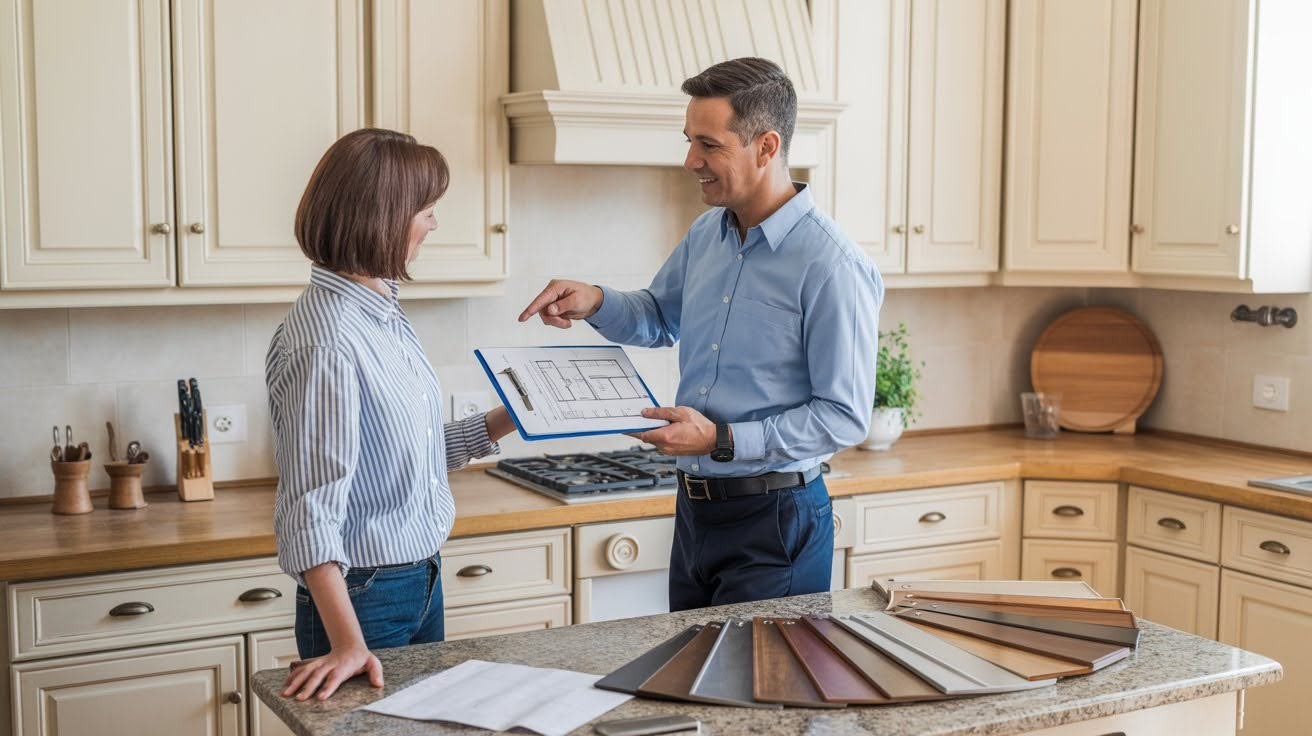
Getting accurate cabinet refacing quotes requires professional consultations, precise measurements, upgrade decisions, and detailed cost breakdowns from multiple contractors.
Schedule a Professional Consultation
Contact multiple cabinet refacing contractors for in-home consultations to get the most accurate pricing estimates.
Professional contractors assess your existing cabinet condition, kitchen layout, and specific requirements that online calculators miss.
Request consultations from at least three licensed professionals to compare pricing and approaches.
Most reputable contractors offer free consultations, making this essential for gathering comprehensive cost information.
Measure Cabinets and Count Doors/Drawers
Prepare detailed cabinet inventories before contractor visits by counting all doors, drawer fronts, and measuring their dimensions.
Measure linear footage of cabinet face frames and document unusual sizes or specialty configurations.
Take photos from multiple angles to share with contractors. Having this information ready speeds up quoting and ensures all contractors price the same scope of work.
Decide on Trim and Accessory Upgrades
Determine which additional features you want before requesting final quotes, including crown molding, decorative panels, and storage upgrades like pull-out shelves or lazy Susans.
Choose hardware styles and quality levels that fit your budget. Having these decisions made allows contractors to provide comprehensive quotes rather than estimates that might change significantly.
Request a Breakdown of Labor vs. Materials
Ask contractors to separate material costs from labor charges in written quotes for better cost understanding.
This breakdown helps compare proposals between contractors and identify where money is spent.
Understanding these costs allows you to research alternatives and evaluate professional installation value versus DIY approaches.
Conclusion
After helping countless homeowners through cabinet refacing projects, I’ve seen how this renovation approach consistently delivers impressive results while keeping budgets realistic.
Most projects fall between $5,000 for smaller kitchens and $15,000+ for expansive spaces, with your material choices and upgrade selections playing the biggest role in final costs.
What I love about refacing is how it gives you that fresh, modern look you’re craving without turning your home into a construction zone for months.
I’ve watched families continue cooking dinner while their kitchen gets a complete makeover in just a few days.
However, I always recommend full replacement when cabinet boxes show serious wear or you need layout changes.
The key is honest assessment of your existing cabinets’ condition and your long-term goals. With proper planning and realistic expectations, refacing can give you the kitchen update you want at a price that makes sense.
Frequently Asked Questions
How much does cabinet refacing cost in 2025?
Cabinet refacing typically costs between $5,000 and $15,000, depending on kitchen size and material choices. Small kitchens start around $5,000, while large or custom kitchens can exceed $15,000 with premium materials and upgrades.
How long does a cabinet refacing project take?
Most cabinet refacing projects are completed within 3-7 days, depending on kitchen size and complexity. This timeline is significantly shorter than full kitchen remodels, which can take 4-6 months to complete.
Is cabinet refacing worth the investment?
Yes, cabinet refacing provides excellent value by updating your kitchen’s appearance at 30-50% less cost than full replacement. It’s particularly worthwhile when existing cabinet boxes are structurally sound and the layout functions well for your needs.
What materials can I choose for refaced cabinets?
You can select from various materials including laminate, thermofoil, wood veneer, and solid wood options. Each material offers different price points, durability levels, and aesthetic qualities to match your budget and style preferences.
Can I reface cabinets myself or should I hire professionals?
While DIY refacing is possible, professional installation ensures proper fit, finish, and warranty coverage. Professionals have specialized tools and experience that typically result in better long-term durability and appearance than DIY attempts.

